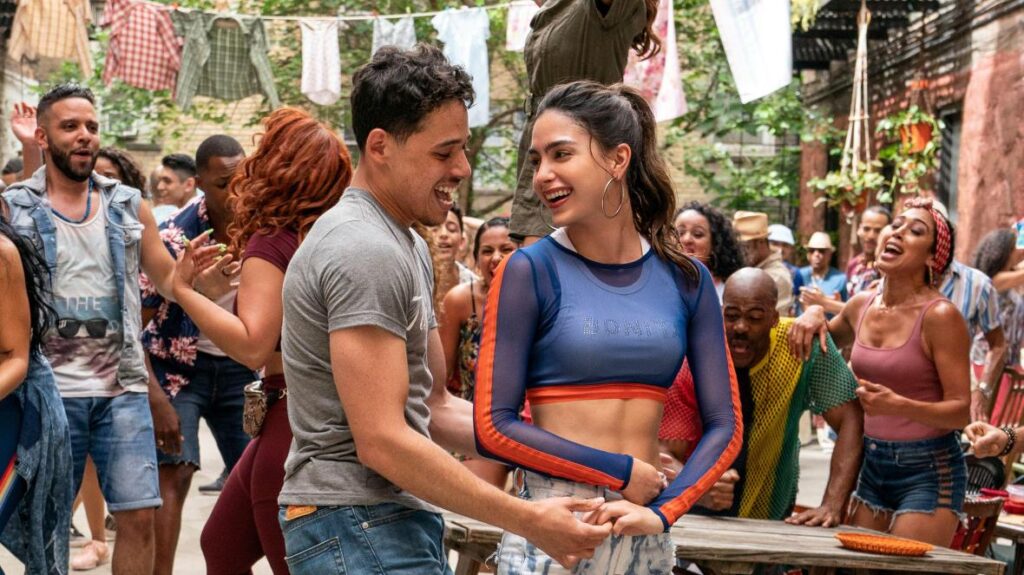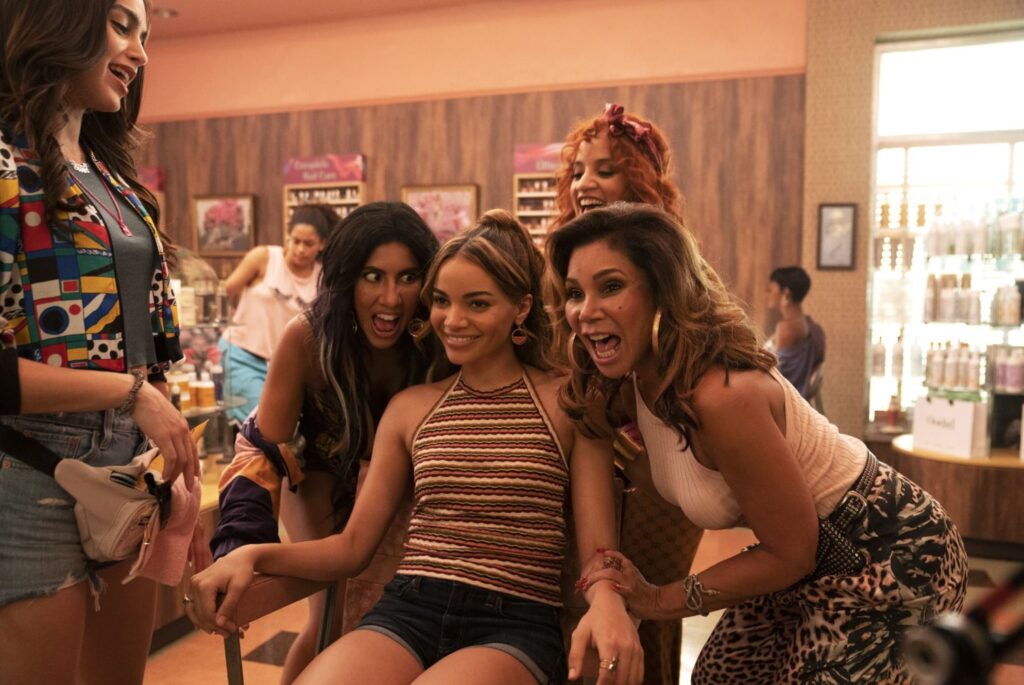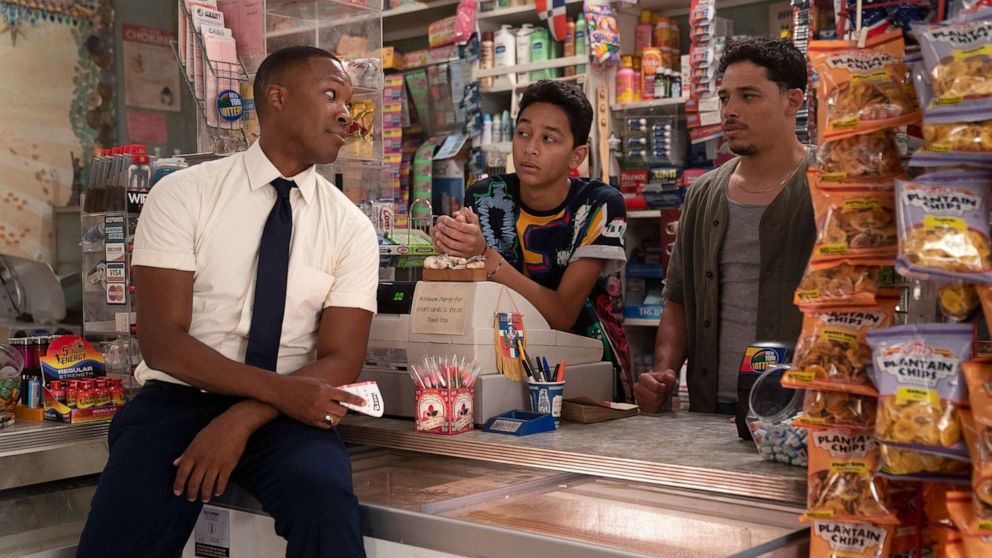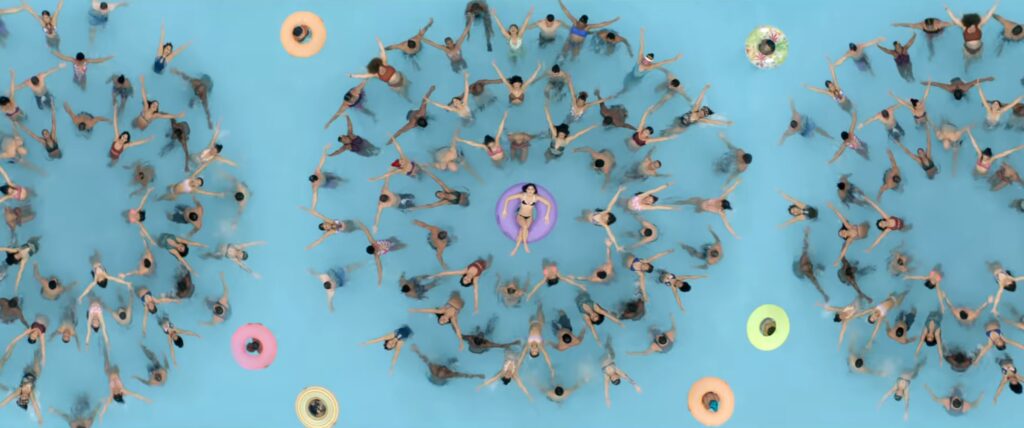
“96,000,” the undeniable centerpiece of Jon M. Chu’s In the Heights, is a dizzying, dazzling musical number, a vibrant and symphonic sequence that opens on a sunbaked street, parades through a crowded neighborhood, and eventually unites what feels like a cast of thousands in a luminous public pool. Yet as propulsive and audacious as it is, the moment the song made me gasp is almost invisible; early on, when rhapsodizing about (and exaggerating) his own talents, a graffiti artist invokes the name of Obi-Wan Kenobi and then—as if from thin air—pulls out a lightsaber.
Not really, of course; as gifted and ambitious as these residents of Washington Heights may be, they aren’t actual Jedi knights. Instead, Obi-Wan’s intergalactic weapon appears as a puff of greyish shadow only to just as suddenly vanish, along with other mentioned objects like a golf club and a sparkling diamond. It’s a mild visual flourish, but it embodies the spirit of creativity that makes this Broadway adaptation sing. In all likelihood, a point-and-shoot version of Lin-Manuel Miranda’s first stage hit would have been entertaining; hell, the Disney+ broadcast of Miranda’s Hamilton was largely delightful, and it was literally just footage from theatrical performances. But while In the Heights obviously can’t approach that masterpiece in terms of writing or depth, Chu’s big-screen vision is nonetheless a robust and imaginative work. And that’s because it’s unashamedly a movie musical—emphasis on “movie”.
Chu, who’s previously helmed a handful of musicals (including two Step Up sequels), demonstrates his fluency in song-and-dance cinema right from the start. (Well, almost from the start; the film’s prologue introduces its pointless framing device in which a character narrates the events to a group of eager children, a misguided attempt to gin up faux suspense.) Aside from “96,000” (whose title refers to the dollar amount of a fateful winning lotto ticket), the most memorable set piece in In the Heights is its titular opening number, which begins with bodega owner Usnavi (an excellent Anthony Ramos) groggily rising from bed and strolling down a Manhattan street to unlock his store. It’s a patient, expansive sequence that’s also economical, efficiently introducing us to most of the main characters whom we’ll be spending the next 143 minutes with. Yet what matters is the way it moves, how it gradually accumulates energy while gliding from one graceful shot to the next. Christopher Scott’s choreography is busy yet precise, while Alice Brooks’ cinematography generates momentum even from stillness; a shot of Usnavi pensively gazing out his storefront, with dancers reflected in the glass, is startling in its quiet beauty.

Perhaps predictably, when the music stops—when the bursts of song and the flurries of hip-hop give way to ordinary scenes of dialogue and exposition—In the Heights becomes less exceptional. This is partly a function of the form; the joyous crests of choral promenading and dramatic soloing are designed to operate as high points relative to the more mundane, foundational building blocks of speech and plot. All the same, once isolated from its fantastical trappings, the film’s story struggles to achieve a similar sense of liftoff. The characters are pert and appealing, but the existential journeys that they undertake—a combination of self-discovery and self-improvement in the face of a cold and unforgiving world—are somewhat familiar and predictable.
This isn’t to suggest that the screenplay, by Quiara Alegría Hudes (who wrote the original play along with Miranda), has nothing new to say. The movie takes seriously the issue of gentrification; when Usnavi tells kids to say the name of his neighborhood aloud “so it doesn’t disappear”, it’s a playful moment, but it also expresses genuine fear of the erasure of Latinx culture in America. (Speaking of which, in the wake of the film’s release, several activists accused it of colorism for failing to cast dark-skinned Afro-Latinx actors in lead roles; Miranda apologized.) There’s a subplot involving DACA, and while it isn’t handled with much subtlety (despite Marc Anthony’s terrific line reading, “You ever wonder why?”), it speaks plaintively to the cloud of uncertainty that lingers over immigrants’ lives. And a scene where a young woman describes being profiled and searched by authorities is pungent in its anger and shame.

Miranda has described In the Heights as a valentine to his childhood neighborhood, which may explain why the film works better as a love letter than a love story; its two central romances are sweet but not especially poignant. Usnavi, who intends to return to his native Dominican Republic and reopen the dormant beachside bar (called El Sueñito, or The Little Dream) previously run by his late father, has long nursed a crush on Vanessa (Vida’s Melissa Barrera), an aspiring fashion designer who imagines starting her own line. There’s something vaguely Apatowian about this pairing, with Ramos playing up Usnavi’s gawky side as he charms a spectacularly beautiful woman who’s smart, talented, and conveniently available; they make a cute couple who’s easy enough to root for, but they never quite acquire the specificity needed to drive home their mutual yearning. The same is true of the tentative connection between Benny (Corey Hawkins), an enthusiastic cab dispatcher, and Nina (Leslie Grace), a Stanford student who questions whether she can start a new life 3,000 miles from home; their devotion is implied rather than felt.
If anything, the most moving relationship is between Nina and her father, Kevin (Jimmy Smits), a local bigwig who carries himself with the same pleasing arrogance that Smits brought to Baz Luhrmann’s The Get Down. Kevin, an old-fashioned striver and glad-hander, wants to build a metaphorical bridge for Nina that stretches from Washington Heights to Palo Alto (thereby ensuring her best possible future), but she pushes back at his equation between escape and success, and the script explores their generational divide with nuance and sensitivity.

Smits’ soothingly recognizable presence brings veteran clout to an ensemble that is otherwise (like its characters) young, spry, and hungry. (Meanwhile, Miranda himself has a small, somewhat distracting part as a piragua salesman who struggles to compete against a franchised soft-serve merchant; Hamilton fans will smile at the actor who plays his foil, and will also chuckle at the snippet of hold music that recalls a David-and-Goliath battle of a different sort.) The whole cast is solid (in particular Daphne Rubin-Vega’s salon proprietor), but if In the Heights will make a star out of anyone, it’s Ramos. As a rapper, he exhibits a steady command of flow, even if his singing is nothing special. But what’s really striking is his twitchy intelligence and restlessness—the sense that he’s practically combusting from all of the thoughts and desires tumbling around inside his brain and body. (He’s currently demonstrating the same quality, in a far different manner, on the HBO series In Treatment.)
And if the characters of In the Heights aren’t all that well-rounded, they nevertheless satisfactorily fulfill their role as delivery vehicles for Miranda’s lyrics, which Chu in turn embellishes with variety and dexterity. It’s hard to say whether Miranda’s songwriting itself is especially impressive, but that doesn’t matter; what seems indisputable is the film’s brilliant marriage of the verbal and the visual. Chu, who previously flaunted his gift for glamour with Crazy Rich Asians (next up: an adaptation of Wicked), is an unapologetic showman, and the musical numbers of In the Heights hum with bravado and ingenuity. The highlights include “Carnaval del Barrio”, a boisterous piece of communal celebration that turns sweltering heat into lively electricity; “Champagne,” a tender tête-à-tête between Usnavi and Vanessa that sweeps through his apartment in a single, fluid take; and “Paciencia y Fe”, a lovely ballad that flashes backward and forward in time as a dying woman (Olga Merediz) contemplates her legacy. By the time Nina and Benny are literally dancing up and down the sides of a brick building in their inspired duet “When the Sun Goes Down”, you’ll be walking on air right along with them.
That giddy sense of levitational exuberance is what makes In the Heights such an enjoyable experience. It isn’t a perfect movie. But it is an emphatic testament to the virtues of bold, grandiose filmmaking—a buoyant reminder that at the movies, little dreams can come in big packages.
Grade: B+
Jeremy Beck is the editor-in-chief of MovieManifesto. He watches more movies and television than he probably should.
